What is Stitch in Garments?
Seams and stitches are inseparably involved with each other. Because, seams cannot be made without stitches and stitches also cannot be made without seams. It is necessary to know the definition of stitches prior to the discussion about different types of stitches, so the definition of stitches is given. One or more than one thread or thread loops are sewn by intralooping or by interloping or by interlacing each other and the units of those sewing are called stitches. When one loop of a thread passes through another loop of the same thread, then it is called the intralooping. When one thread passes over another thread or loop of the thread, then it is called the interlacing. When one loop of a thread passes through the loop of another thread, then it is called the interloping. When one layer of fabric is sewn, then it is called stitching, for example, edge neatening of fabric, hem, etc.
Different Types and Classes of Sewing Stitches:
About 70 types of stitches are seen to be used out of which 18 to 20 types of stitches are being used largely in garments industries. But in tailoring shops or in houses 2 to 3 types of stitches are used for making of garments. All types of stitches can be classified under six classes. Discussion on different types of stitches of each of the classes has been done below with examples and images.
Stitch Class-100 (Chain stitch):
The stitches under this class are made by the help of one or more than one needle thread intralooping. The needle thread enter into the fabric with the help of needle and make the loop of needle thread and the made loop is confined with the following loop made by the same needle thread. This way one after another rows of stitches are made. The security of this type of stitches is very low, because if the end of the thread in stitches is not passed through the last loop or is not passed separately through the fabric or if any stitches break then very easily the whole sewing is open in one pull. The most ordinary stitch type-101 of this class has been shown in figure-1.
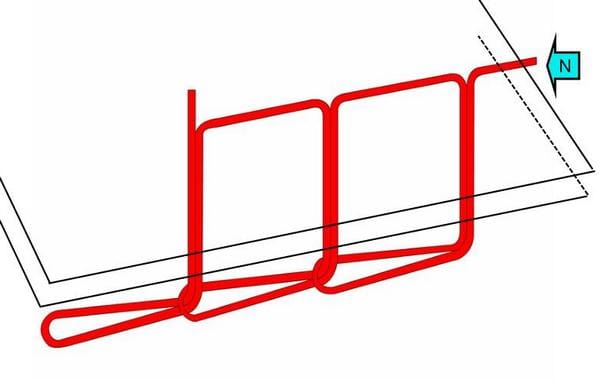
As the security of this class of stitches is less, they are used for temporarily joining, such as, for maintaining the right positioning of collar, flap etc. Also these are used for making the gathered appearance by sewing with elastic thread in multiple needle of machines at cuff and waist. Stitch type-103 is regularly used in sewing button holes, button stitching and blind hemming. If the button hole stitching or button attaching is done by stitch type-103, they do not last long with the garment life. The speciality of blind stitch is that it is not seen from the face side of the garment and for this reason it is frequently used in making blind hem.
Stitch class-200 (Hand stitch)
The stitches under this class have been designed resembling the handmade sewing. With the help of needle, the needle thread is entered into the fabric from one side to the other and a sewing line is made. This type of sewing is like the hand stitching to look at. Hand stitching is very time consuming and it requires experience to make and for the reason, arrangement has been made to make this type of stitches by special type of sewing machines and needles.
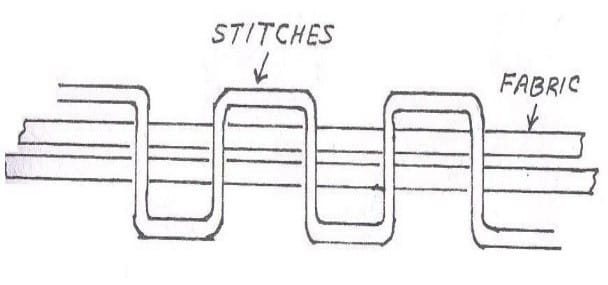
Stitch type-209 is frequently used at the end of a jacket. This type of stitch is made by special type of needles that means narrow at two sides and needle eye at the middle and sewn by special type of sewing machine. But in this process, it is possible to sew in small length and the speed of the sewing is also comparatively much less but comparing to the hand stitching, it is much speedy. Normally this type of stitching is used in making costly garments. Stitch type-209 has been shown above in figure-2.
Stitch class-300 (Lock stitch)
The stitches of this type are made by the threads of two or more groups and threads of one group are interlinked with the other through interlacing. One group of thread is called the needle thread and the other group of thread is called the bobbin thread. Out of this class, stitch type-301 is used mostly which is made by a needle thread and a bobbin thread. Stitch type-301 has been shown in figure-3. Sufficient strength and extensibility are found in lockstitch but good quality of thread has to be used and the balance of thread tension in sewing has to be maintained. 30% or more stitch extensibility may be obtained in lock stitches. The most remarkable characteristic of lockstitches is that it is seen same from the both sides of the fabric, which is absent in any other stitches. The stitches in this type are well secured that means they do not untie from the ends or even the sewing is broken at any places, there is no immediate risk of opening of the whole sewing at a time. If backtacking is done at the beginning and the end, then sufficient security of sewing is achieved. Due to the embedding of the sewing thread of stitches in fabrics, this type of stitches has a good abrasion resistance.
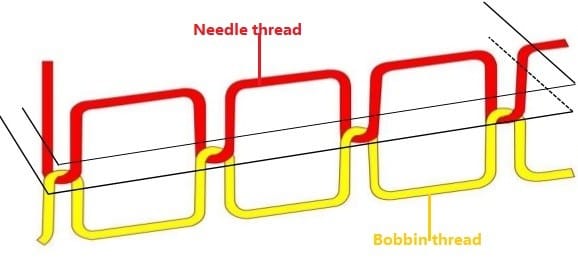
The stitch type-304 of this class which resembles zig-zag shape are made by one needle thread and one bobbin thread. This zig-zag stitch is used for attaching lace or elastic with fabrics or garments.
The most downside of the lockstitch is that the under thread or the bobbin thread is supplied by bobbin and due to the very small volume of the bobbin, it can hold threads of small distance, as a result, bobbin is replaced after sewing of only a small distance, which is a big time consuming problem. Specially, if the thread in bobbin case is finished on the middle path of a sewing, then in some cases new sewing is done starting from the beginning after opening of the sewn portion. In the case where, sewing is done with twin needle simultaneously in two lines side by side, if the thread of one bobbin is finished on the middle path, then that becomes more inconvenient. But now a days some highly modern machines have been designed where signal is received before the finishing of the thread in bobbins. Another big drawback is that the extensibility property of this type of stitch is much low which is not convenient for sewing of the knitted garments. But in some stitches like stitch type-304, the extensibility is comparatively good.
This type of stitches are widely used for ordinary sewing and for joining such as, widely used for joining of pocket, collar, cuff, facing etc. without this, these stitches are also used for top stitching, button holing, button attaching, blind stitching etc.
Stitch class-400 (Multi thread chain stitch)
The stitches of this class are made by threads of two or more than that of groups. The loop of one group of thread entering into the fabric interlinks with the threads of other groups by interlacing and interloping. One group of thread is called the needle thread and the thread of the other group is called the looper thread.
Stitch type-401 is the most easy and most used stitch type of this class, which is made by one needle thread and one looper thread. The upper surface of the fabric looks like lockstitches but in the lower side it looks like double chain. Sometimes this chain stitches are called double stitches, because one needle thread is linked with two loops of the lower thread. The most suitable side of the chain stitches of this class is that strength of two thread chain stitch is far stronger than the similar lock stitch that means the two thread lock stitch. Interlocking is made between two groups of threads in lower side. There is less chance of seam puckering in chain stitch. In addition to that thread is supplied from both the groups of upper and lower from “cones of thread”, and for this reason, no problem arises due to the finishing of threads in bobbins.
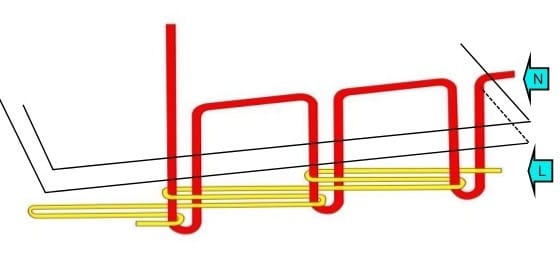
This can be made by one or more than one needle sewing machines. About 1 cm of chain of thread should be kept at the end of the sewing, otherwise sewing can be easily opened from the ending side. The last end cannot be backtacking but stitch density can be increased. The extensibility of the stitches are largely similar to lockstitches.
Chain stitch is made comparatively in less tension of thread for which the chain stitch machine can be operated in more speed than the lockstitch. For example, the speed of lockstitch machine is 6000 S.P.M but the speed in chain stitch machine is 8000 S.P.M. but in production, normally sewing is not done in so high speed.
Stitch type-401 has been shown above in figure-4. Stitch type-401 is frequently used in the long seam of trousers and for making garments of jeans fabrics. On the other hand, stitch type-401 can also be used side by side and simultaneously with over edge stitch. Without this, stitch type-406, 407 and 411 of this class have been shown. These stitches are made by using multiple needles. These stitches are frequently used for joining lace, braid and elastic in the garments.
Stitch class-500 (Over edge stitch)
The stitches of this class are made by one or more than one group of threads and the loop of thread of at least one group interlinks it after returning back from the end of the fabrics. As a result, the fabric thread cannot come out from the ends of the fabric, this means it stops fraying. Just before sewing, with the help of knife present in the machine, the clean end of the fabric is made ready for this seam by cutting of the fabric end. Thus type of stitches are sometimes also called over locking but practically this is over edge stitch.
Stitch type-504 has been shown figure-5, which has been made by one needle thread and two looper thread. It is used mainly in neatening at the edge of fabrics and in making seams in knitted fabrics. The stretch of this stitch is very good. The width of the stitch is normally 3-5 mm. some additional chain should be kept at the end of the stitch and the stitch should be secured with sewing so that sewing is not opened at the end of the stitch. This stitch is used also for decoration at the edge of the fabric.
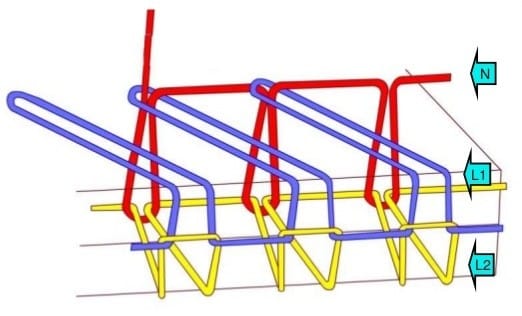
The other stitches under this class, for example, stitch type-503, 512, 514 are being used in large scale. 512 is for light fabric and 514 for heavy fabric such as denim, jeans, cord etc are frequently used for sewing of fabrics. Also stitch class-400 and stitch class-500 are used at a time side by side very frequently. Such as the combination stitch of 401 and 503. The special characteristics of this class of stitches is that the extensibility of some of the stitches may be up to 300%.
Stitch class-600 (Covering chain stitch)
The stitches under this class are made with the threads of three groups and threads of two groups are seen on the face side of the fabric. The thread of the first group is called needle thread, the threads of second and third groups are called top cover thread and bottom cover thread. The stitches of this class are very complicated and up to 9 thread may be used for making stitches are seen.
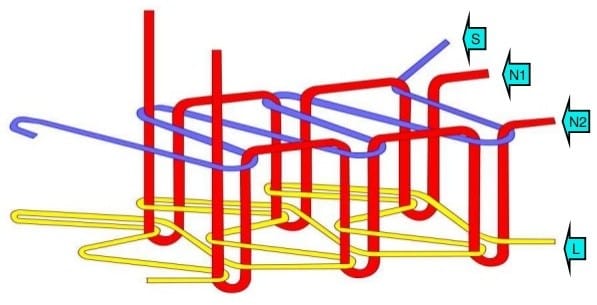
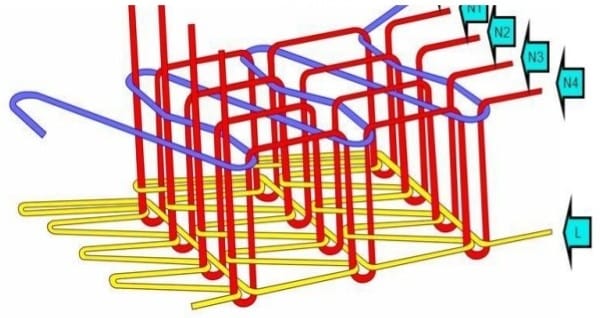
In figure-6, stitch type-602 and in figure-7, stitch type-606 have been shown above. In making stitch type-606, total 9 threads have been used including 4 needle thread and it is known as flatlock. Flatlock is used much for sewing knitted fabric, specially for the sewing of underwear. It is used in decoration for leisure wear also. Stitch type-602 is used for joining lace, braid, elastic etc. with the garments. In addition to that, this stitch is also used for making stitch at the edge of the fabric, decorative stitch and top stitching.
